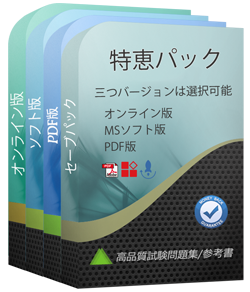Tech4Examはどんな試験参考書を提供していますか?
テストエンジン:SEND試験試験エンジンは、あなた自身のデバイスにダウンロードして運行できます。インタラクティブでシミュレートされた環境でテストを行います。
PDF(テストエンジンのコピー):内容はテストエンジンと同じで、印刷をサポートしています。
SENDテストエンジンはどのシステムに適用しますか?
オンラインテストエンジンは、WEBブラウザをベースとしたソフトウェアなので、Windows / Mac / Android / iOSなどをサポートできます。どんな電設備でも使用でき、自己ペースで練習できます。オンラインテストエンジンはオフラインの練習をサポートしていますが、前提条件は初めてインターネットで実行することです。
ソフトテストエンジンは、Java環境で運行するWindowsシステムに適用して、複数のコンピュータにインストールすることができます。
PDF版は、Adobe ReaderやFoxit Reader、Google Docsなどの読書ツールに読むことができます。
あなたはSEND試験参考書の更新をどのぐらいでリリースしていますか?
すべての試験参考書は常に更新されますが、固定日付には更新されません。弊社の専門チームは、試験のアップデートに十分の注意を払い、彼らは常にそれに応じてSEND試験内容をアップグレードします。
更新されたSEND試験参考書を得ることができ、取得方法?
はい、購入後に1年間の無料アップデートを享受できます。更新があれば、私たちのシステムは更新されたSEND試験参考書をあなたのメールボックスに自動的に送ります。
割引はありますか?
我々社は顧客にいくつかの割引を提供します。 特恵には制限はありません。 弊社のサイトで定期的にチェックしてクーポンを入手することができます。
あなたのテストエンジンはどのように実行しますか?
あなたのPCにダウンロードしてインストールすると、MRCPUK SENDテスト問題を練習し、'練習試験'と '仮想試験'2つの異なるオプションを使用してあなたの質問と回答を確認することができます。
仮想試験 - 時間制限付きに試験問題で自分自身をテストします。
練習試験 - 試験問題を1つ1つレビューし、正解をビューします。
返金するポリシーはありますか? 失敗した場合、どうすれば返金できますか?
はい。弊社はあなたが我々の練習問題を使用して試験に合格しないと全額返金を保証します。返金プロセスは非常に簡単です:購入日から60日以内に不合格成績書を弊社に送っていいです。弊社は成績書を確認した後で、返金を行います。お金は7日以内に支払い口座に戻ります。
購入後、どれくらいSEND試験参考書を入手できますか?
あなたは5-10分以内にMRCPUK SEND試験参考書を付くメールを受信します。そして即時ダウンロードして勉強します。購入後にSEND試験参考書を入手しないなら、すぐにメールでお問い合わせください。
MRCPUK Endocrinology and Diabetes (Specialty Certificate Examination) 認定 SEND 試験問題:
1. A 28-year-old woman was referred with an 8-year history of progressive weight gain, hypertension and abdominal striae. She had no family history of note and was not taking any medication.
On examination, her blood pressure was 158/86 mmHg. There was central obesity with abdominal striae. There was mild proximal myopathy of the lower limbs.
Investigations:
serum sodium143 mmol/L (137-144)
serum potassium3.4 mmol/L (3.5-4.9)
low-dose dexamethasone suppression test (2 mg/day for 48 h):
serum cortisol180 nmol/L (<50)
An MR scan of pituitary showed an invasive adenoma extending laterally into the cavernous sinuses bilaterally. Superiorly, the adenoma was in contact with, but not distorting, the optic chiasm. Formal visual field examination was normal.
What is the most appropriate next step in management?
A) pituitary radiotherapy
B) bilateral adrenalectomy
C) trans-sphenoidal hypophysectomy
D) adrenolytic therapy
E) somatostatin agonist therapy
2. A 32-year-old woman with a recurrent history of Graves' thyrotoxicosis was being considered for radioiodine treatment. However, she wanted to conceive again at some stage and asked how soon she could become pregnant.
After what minimum interval would it be safe for her to conceive again?
A) 6 months
B) 12 months
C) 2 months
D) 4 months
E) 8 months
3. A 55-year-old woman presented complaining of difficulty losing weight.
On examination, her blood pressure was 170/105 mmHg and urinalysis showed protein 1+.
An ultrasound scan of abdomen revealed a 4.5-cm solid lesion in the right adrenal gland. She was treated with ramipril and further endocrine evaluation was performed.
Investigations:
serum potassium3.6 mmol/L (3.5-4.9)
serum creatinine135 umol/L (60-110)
plasma renin activity:
(after 30 min supine)3.9 pmol/mL/h (1.1-2.7)
(after 30 min upright)6.8 pmol/mL/h (3.0-4.3)
plasma aldosterone:
(after 30 min supine)150 pmol/L (135-400)
(after 4 h upright)350 pmol/L (330-830)
serum cortisol (09.00 h)650 nmol/L (200-700)
serum cortisol (22.00 h)225 nmol/L (50-250)
24-h urinary free cortisol230 nmol (55-250)
24-h urinary dopamine3200 nmol (<3100)
24-h urinary adrenaline120 nmol (<144)
24-h urinary noradrenaline450 nmol (<570)
What is the most appropriate initial management of the adrenal lesion?
A) ?-adrenoceptor blockade
B) mineralocorticoid receptor blockade
C) surgical excision
D) medical observation with annual ultrasonography
E) angiotensin-2 receptor blockade
4. A 48-year-old man with an 8-year history of type 2 diabetes mellitus was referred because of poor glycaemic control. He had a history of myocardial infarction complicated by previous congestive cardiac failure. His current medication comprised metformin 850 mg three times daily and gliclazide 80 mg once daily. He had gained weight and his body mass index was 31 kg/m2 (18-25).
Investigations:
serum sodium143 mmol/L (137-144)
serum potassium4.4 mmol/L (3.5-4.9)
serum creatinine136 umol/L (60-110)
haemoglobin A1c74 mmol/mol (20-42)
According to NICE guidelines (CG87, May 2009), what is the most appropriate immediate next step in management to improve his glycaemic control?
A) increase the dose of gliclazide
B) start insulin treatment
C) add sitagliptin
D) add pioglitazone
E) add exenatide
5. A 28-year-old Asian woman was seen in the joint diabetes-antenatal clinic at 16 weeks' gestation. She gave a history of gestational diabetes during her previous pregnancy. She had a strong family history of diabetes mellitus. She was fit and well, and had no symptoms other than slight early morning sickness.
According to NICE guidance (NG3, February 2015) for management of pregnancy, what is the most appropriate way to screen for gestational diabetes in this woman?
A) 2-h postprandial plasma glucose
B) oral glucose tolerance test as soon as possible
C) haemoglobin A1c
D) fasting plasma glucose
E) oral glucose tolerance test at 24-28 weeks' gestation
質問と回答:
| 質問 # 1 正解: C | 質問 # 2 正解: A | 質問 # 3 正解: C | 質問 # 4 正解: A | 質問 # 5 正解: B |


 弊社は製品に自信を持っており、面倒な製品を提供していません。
弊社は製品に自信を持っており、面倒な製品を提供していません。



 -滝*梓
-滝*梓

